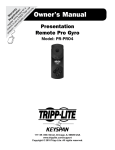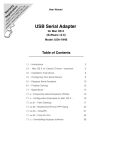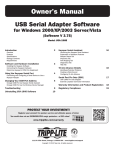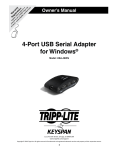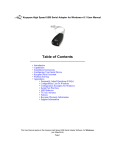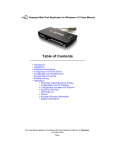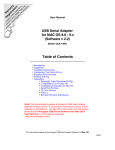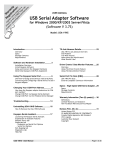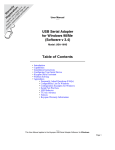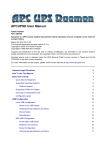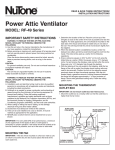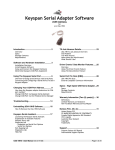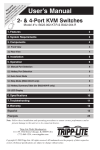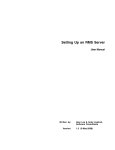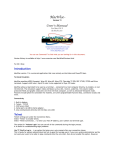Download Owner`s Manual 4-Port USB Serial Adapter for Mac®
Transcript
pr ch re od an gi R Wa uc ce ste eg rr t— to r o is a w w nli tra nty w in n w. a e tio tri F to n pp R da : lit EE y f e. T o co ri r a m pp /w L ar ite ra nt y Owner’s Manual 4-Port USB Serial Adapter for Mac® Model: USA-49WG 1111 W. 35th Street, Chicago, IL 60609 USA www.tripplite.com/support Copyright © 2010 Tripp Lite. All rights reserved. Keyspan is a trademark of Tripp Lite. 4-Port USb Serial Adapter for Mac® Model: USA-49WG Table of Contents 1.1 - Introduction 3 2.1 - Installation Instructions 4 3.1 - Configuring Your Serial Device 6 4.1 - Keyspan Serial Assistant 8 5.1 - Problem Solving 10 6.1 - Appendices 12 6.1.a - Configuration Examples for Mac OS X 13 6.1.b - Palm Desktop 14 6.1.c - Modem/Cell Phone PPP Setup 19 6.1.d - VirtualPC 24 6.1.e - Final Cut Pro 32 6.1.f - Un-installing Keyspan software 35 Page 2 1.1 - Introduction The Keyspan USB Serial Adapter Software for Mac OS X allows you to add serial ports to your Mac OS X computer. Using Mac OS X native software, you can use your Keyspan USB to Serial Adapter to communicate with various serial devices via the POSIX API. Important Note: The Keyspan USB Serial Adapter Software for Mac OS X will add 'Mac OS X serial ports' to your computer. These 'Mac OS X serial ports' can only be used by Mac OS X native software (a program that does not require the Classic environment to run). If you are not certain if your serial device's software can access Mac OS X serial ports, please read the Serial Ports - Mac OS X vs 'Classic' Mac OS section in this manual. Examples of serial devices that use Mac OS X serial ports are modems using PPP (for internet access - configured via the Networking System Pref erence icon), Palm Handhelds (using Palm's HotSync Manager), and UPS devices. Requirements The Keyspan USB Serial Adapter Software for Mac OS X requires the following: · Macintosh: · At least one available USB port · Mac OS X (10.2.8 or greater) Page 3 2.1 - Installation Instructions Installing the USB Serial Adapter Software for Mac OS X Step 1 - Insert the Keyspan Serial Adapter CD-ROM Place the CD into the CD-ROM drive. When the CD icon appears on your desktop, double click on this icon to display its contents. Locate the Keyspan Mac OS X folder and then locate the Keyspan USB Serial Software for Mac OS X Installer. Step 2 - Run the Keyspan USB Serial Software for Mac OS X Installer Run the Keyspan USB Serial Software for Mac OS X Installer by double clicking the Keyspan USB Serial Software for Mac OS X installer icon. This will start the installer. Once the installer is running, follow the instructions on screen. Note: The installer requires that you enter an administrator password before the Keyspan software can be installed. Generally, this password will be the same as your standard password. To enter the password, click on the lock icon in the lower left-hand section in the installer window. The Keyspan USB Serial Adapter software is now installed. Step 3 - Software Installation Complete! Now that you have installed the Keyspan USB Serial Adapter software, you are ready to install the Keyspan USB Serial Adapter hardware. Please proceed to the installing the Keyspan USB Serial Adapter Hardware instructions. Page 4 Installing the Keyspan USB Serial Adapter Hardware The following hardware installation instructions provide a basic overview on installing the Keyspan USB Serial Adapter in a USB port. For detailed instructions on how to connect USB devices your specific computer, please refer to the USB Device Install section in your computer's user's manual. Step 4 - Connect the USB Cable to the Adapter (if necessary) If your Keyspan adapter does not have an attached USB cable, attach the included USB cable into the Keyspan adapter's USB port. Step 5 - Connect the Adapter to Your USB Port Attach the Adapter to your computer by connecting the Adapter's USB cable into any built-in USB port on your computer or USB Hub. It is not necessary to turn off your computer when attaching the Adapter. Step 6 - Hardware Installation Complete! Your Keyspan USB Serial Adapter is ready for use now that you have installed hardware and software. Please proceed to the Keyspan Serial Assistant section in this manual for instructions on what to do next. Page 5 3.1 - Configuring Your Serial Device Prior to using your serial device (modem,UPS, etc.) with the Keyspan USB Serial Adapter, you must: 1. Connect your serial device (hardware) to the Keyspan port . 2. Configure your serial device's software to use the Keyspan port. The following instructions provide a general overview of this process. Connecting Your Serial Device (Hardware) If your Keyspan adapter is not connected, please do so NOW. Step 1 - Connect Your Serial Device to the Keyspan Adapter Attach your serial device's serial cable to the serial port on your Keyspan USB Serial Adapter. Step 2 - Determine Which Keyspan Port Your Serial Device is Connected To If you have a Keyspan product that has more than one serial port, please note which Keyspan serial port your serial device is connected to (the serial port on the Keyspan product, not your USB ports on your computer or USB hub). This information will become useful as we start Configuring Your Serial Device's Software. Configuring Your Serial Device's Software The following configuration instructions provide a basic overview of how to configure your software to use your Keyspan serial port(s). For specific instructions on how to operate your serial device, please refer to that device's user's manual for detailed instructions. Page 6 Step 3 - Determine Where to Select/Configure the Keyspan Serial Port(s) Prior to using your serial device with a Keyspan serial port, you must first tell that serial device's software which Keyspan serial port your device is connected to. Most serial devices will have software that will allow you to select which serial port the device is connected to. Depending on your serial device and its software, you may have to configure: a System Preference item (modems accessing ISPs), an application (UPSes), or some combi nation of these (modems accessing terminals using Zterm). Please refer to your serial device's documentation on which method your serial device uses and how to access that software's serial port "configuration" screen. Once you've determined where to select or configure your serial device's software's serial port settings, please proceed to Step 4. Step 4 - Determine Which Serial Port to Select in Your Serial Device's Software When you've found the port selection screen in your serial device's software, you may be presented with a list of serial port names. If you have a Keyspan device that only has one serial port, simply select the port name that starts with the letters USA. If you have a Keyspan device that has two or more serial ports, you will have more than one choice in your list of ports. Depending on the software, you should be able to see several ports with the letters USA. These ports will end with a number that corresponds to the port number on the adapter. For example, a port named "USA28X9132 " is referencing to the second port on a Keyspan USB Twin Serial Adapter (part number USA-28X). The numbers before the last number refer to location of that adapter on the USB bus. In this case, "913" is reporting that the adapter is on USB bus # 9, host hub port # 1 and external hub port # 3. Step 5 - Use Your Serial Device Once you've configured your serial software to use the Keyspan serial port, you're ready to start using your serial device under Mac OS X. Page 7 4.1 - Keyspan Serial Assistant Besides the required drivers, the Keyspan USB Serial Adapter software installer installs an application called Keyspan Serial Assistant. This application is used to: · · · · Show the names of the installed serial ports Show which Keyspan adapters are connected Determine the status of the adapter software and hardware Assist in problem solving Launching the Keyspan Serial Assistant To launch the Assistant, double click the "Keyspan Serial Assistant" icon in your Applications folder. This will open the Keyspan Serial Assistant window. Page 8 The Keyspan Serial Assistant will display any Keyspan USB Serial Adapters connected to your computer. You can also see the names of the Keyspan serial ports by clicking on the TRIANGLE next to the Adapter icon as shown below: Once you know the names of the Keyspan ports, you can then select the appropriate port name in your serial device's software. The Settings Menu The Keyspan Serial Assistant's Settings menu is located in the Menu bar and provides access to the following command(s): · The Un-install USB Serial Extension command un-installs the Keyspan USB Serial extension. For specific instructions on how to use this feature, please read the Un-installing Keyspan software section in this guide. Page 9 5.1 - Problem Solving If you are having problems with your Keyspan USB to Serial Adapter in Mac OS X, please read the following instructions to assist you in troubleshooting. Hardware Troubleshooting Step 1 - Use the Keyspan Serial Assistant Launch the Keyspan Serial Assistant application. When you open the Keyspan Serial Assistant application, you should see your Keyspan adapter in the list of available adapters. Software/Serial Device Troubleshooting Step 2 - Is Your Serial Device Mac OS X Compatible Check to make certain that your serial device is compatible with Mac OS X. Step 3 - Check the Physical Connections Make certain that your serial device is powered on and is properly connected to the Keyspan Serial Adapter. Page 10 Step 4 - Check Your Serial Device's Software Configuration Check to see if your serial device's software is configured to use the Keyspan port. Please refer to your serial device's documentation for instructions on how to select/switch/configure a serial port in that software. Page 11 6.1 - Appendices · Configuration Examples for Mac OS X Instructions on how to configure selected hardware and software ( VirtualPC, Final Cut Pro, Palm) · Uninstalling Keyspan software Instructions on how to uninstall the USB Serial Adapter software for Mac OS X Page 12 6.1.a - Configuration Examples for Mac OS X The following is a list of available configuration examples for Mac OS X. These example provide step-by-step instructions on configuring select serial devices. The current examples available are: · · · · Palm Desktop for Mac OS X Modems and Cell Phones (PPP) VirtualPC Final Cut Pro Page 13 6.1.b - Palm Desktop Before you begin... This Configuration Example assumes that you have already done the following: 1. Installed the Keyspan serial port hardware and software. 2. Installed the Palm Desktop software. 3. Connected the Palm Serial Cradle hardware to a Keyspan serial port. If you have not performed any of the steps mentioned above, please do so before proceeding. Step 1 - Check the Keyspan Serial Assistant Before proceeding, you should check to see if the Keyspan serial port is installed correctly. To do this, open the Keyspan Serial Assistant (located in your Applications folder). When you open the Keyspan Serial Assistant, you will see a window similar to the one shown below: If your Keyspan hardware and software are installed correctly, the 'Serial Ports' text box will show an icon of your Keyspan serial product. Page 14 Click on the TRIANGLE to the left of your Keyspan icon. This will display the names of the serial port(s) on that Keyspan product as shown below: *** IMPORTANT *** Note the serial port name in the Keyspan Serial Assistant. We will be selecting this port name in the Palm software later. Note: If you have a Keyspan product that has more than one serial port, note the serial port name of the serial port that your Palm is con nected to. Typically, the last 2 letters indicate the port number on your Keyspan hardware (P1 = port 1, P2 = port 2, etc.). Step 2 - Open the HotSync® Manager application Before you can begin to HotSync your Palm, you must access and configure the HotSync® Manager application. The HotSync Manager is the program that manages the serial communication between your Palm and your computer. Page 15 The easiest way to access the HotSync Manager is via the Palm Desktop software. To do this, launch the Palm Desktop software. When the Palm Desktop software is running, go to the "HotSync" menu and select the "Setup" command. Once the HotSync® Manager application is opened, you will be presented with the HotSync Software Setup window. Step 3 - Configure the HotSync Software Setup Window In the HotSync Software Setup window, click on the HotSync Controls tab at the top of the window. This will display the HotSync Controls options. Click on the Disabled radio button to temporarily turn off HotSync monitoring. the HotSync Controls tab and window Then click on the Connection Settings tab at the top of the HotSync Software Setup window. This will display the connection options. Page 16 Turn off the PalmConnect, USB, and Internal Modem connections by unchecking their check boxes. Then turn ON the Keyspan serial port name (see Step 1) by checking its check box. Click on the Keyspan serial port name and click on the Settings button. This will open the settings window as shown below: In the settings window, make sure that the Connection menu is set to SERIAL. The list of numbers below is the list of available baud rates. *** IMPORTANT *** Page 17 If you have a Keyspan USB PDA Adapter with the model number of USA-19, set the baud rate to 57600. For any other Keyspan serial port product (including the Keyspan USB PDA Adapter model numbers USA-19Q and USA-19Qi), set the baud rate to As fast as possible. NOTE: The easiest way to determine the model number of your Keys pan serial adapter is to turn it over. On the back of the adapter is FCC, CE, and other information. The part number is list as "P/N: USA-XXxx" Once you have selected the correct baud rate, click the OK button to return to the Connection Settings window. Then click on the HotSync Controls tab. At the HotSync Controls tab, select the Enabled button as shown below: Step 4 - HotSync Your Palm Organizer Palm Software configuration is now complete. To initiate a 'HotSync' session, place your Palm Organizer in its cradle and then press the HotSync button on the cradle. Your Palm Organizer will now "HotSync." Page 18 6.1.c - Modem/Cell Phone PPP Setup Before you begin... This Configuration Example shows you how to configure a dial-up internet connection (aka PPP connection) via the Network System Preference. In this example, a modem or cell phone is connected to a Keyspan serial port and the Network System Preference is told to communicate with that Keyspan serial port. Before you begin, please make sure that you have done the following: • Installed the Keyspan serial port hardware and software. • Connected the Modem/Cell Phone hardware to a Keyspan serial port. If you have not performed any of the steps mentioned above, please do so before proceeding. Step 1 - Check the Keyspan Serial Assistant Before proceeding, you should check to see if the Keyspan serial port is installed correctly. To do this, open the Keyspan Serial Assistant (located in your Applications folder). When you open the Keyspan Serial Assistant, you will see a window similar to the one shown below: Page 19 Click on the TRIANGLE to the left of your Keyspan icon. This will display the names of the serial port(s) on that Keyspan product as shown below: *** IMPORTANT *** Note the serial port name in the Keyspan Serial Assistant. We will be selecting this port name in the Network System Preference later. Note: If you have an Keyspan product that has more than one serial port, note the serial port name of the serial port that your modem/cell phone is connected to. Typically, the last 2 letters indicate the port number on your Keyspan hardware (P1 = port 1, P2 = port 2, etc.). Step 2 - Open the Network System Preference To open the Network System Preference pane, you must first open the System Preferences window. To do this, select the System Preferences command from the Apple menu as shown below: Once you are in the System Preferences window, click on the Network icon and proceed to Step 3. Page 20 Step 3 - Configure the Network System Preference to Use the Keyspan Serial Port When you first open the Network System Preference window, you may be told that a 'new port has been detected.' This message is normal and is letting you know that the Network System Preference has found a new connection. In this case, the new port/connection is the Keyspan serial port. If you see this message, simply click the OK button. Once you are in the Network System Preference window, select the Keyspan serial port (this is the name of the port from Step 1) from the Show menu as shown below: Once your Keyspan serial port is selected, configure the TCP/IP, PPP, and Proxies tabs as per your Internet Service Provider (ISP; Earthlink, IBM, Mindspring, etc.) instructions. Then click on the Modem tab. Page 21 In the Modem tab, you will need to select a modem script for your modem or cell phone. These modem scripts tell your modem or cell phone how to operate. Select your modem/cell phone from this list and then click the Apply Now button. Important : If you do not see your modem/cell phone in this list, contact your modem/cell phone manufacturer for a "Mac OS X compatible modem script." You have now told the Network System Preference which modem/cell phone you are using and which Keyspan serial port that modem is connected to. Please proceed to Step 4. Step 4 - Configure the Internet Connect Application and Connect to the Internet Open the Internet Connect application. This application is found in your Mac OS X Applications folder. Page 22 Once Internet Connect is open, select the Keyspan serial port from the Configuration menu. Select an access number in Telephone Number menu and enter your account's password if necessary. Click the Connect button to connect to the Internet. Page 23 6.1.d - VirtualPC Keyspan Support For VirtualPC... Information on how to use Keyspan serial products with VirtualPC is provided per the request of VirtualPC users. Keyspan does not support VirtualPC due to the fact that VirtualPC cannot provide the same USB and serial resources that you would find on a 'real' Windows computer. Because of this, serial devices running under VirtualPC (or any emulator) may or may not work. Serial and USB devices expect to communicate with hardware based serial and USB ports. Software based emulators, like VirtualPC, cannot provide the same level of performance as hardware based USB and serial ports. Depending on you serial device and its software, you may or may not be able to reliably use VirtualPC as a way of using a serial device. Please keep this in mind as you read these instructions. Before you begin... This Configuration Example shows you how to configure VirtualPC (with Microsoft Windows) to use a Keyspan serial port. There are two ways of doing this depending on your Keyspan serial product: Method 1 involves VirtualPC emulating COM1 or COM2 by using an existing Mac serial port. This method is compatible with all Keyspan serial ports. This method is recommended for use with DOS programs or any software that is not compatible with Microsoft's 'Win32 Communications API' (any pre-Windows 98 or 2000 programs). Method 2 involves VirtualPC emulating USB and installing Keyspan's Windows software. This method is only compatible with Keyspan serial ports that have Windows software. This method is recommended when you have: a) VirtualPC version 4.0 or later b) a Keyspan serial port that has Windows software. This method is not compatible with Mac only serial ports (USA-28, USA28X, USA-18X, SXPRO, etc.). IMPORTANT!!! YOU CANNOT USE BOTH METHOD 1 and METHOD 2 AT THE SAME TIME. Remember to disable USB is you have VPC set to use COM1/COM2 or disable COM1/ COM2 if you are using the USB. Both methods accomplish the same the same thing (adding a a serial port) but one method may work better than the other depending on what serial device is used, what operating system is installed, which Keyspan serial port is used, etc. or neither method may work. You may be able to find more information on the internet as to how to speed up VirtualPC as this often is a factor in getting a successful outcome. VirtualPC - Method 1 Page 24 This method assumes that you have already done the following: • • • • Installed the Keyspan serial port hardware and MAC software only (not windows). Installed the VirtualPC software. Installed your serial device software in Windows (in VirtualPC). Connected your serial device hardware to a Keyspan serial port. If you have not performed any of the steps mentioned above, please do so before proceeding. Step 1 - Check the Keyspan Serial Assistant Before proceeding, you should check to see if the Keyspan serial port is installed correctly. To do this, open the Keyspan Serial Assistant (located in your Applications folder). When you open the Keyspan Serial Assistant, you will see a window similar to the one shown below: Click on the TRIANGLE to the left of your Keyspan icon. This will display the names of the serial port(s) on that Keyspan product as shown below: Page 25 *** IMPORTANT *** Note the serial port name in the Keyspan Serial Assistant. We will be selecting this port name in VirtualPC later. Note: If you have a Keyspan product that has more than one serial port, note the serial port name of serial port that your modem/cell phone is connected to. Typically, the last 2 letters indicate the port number on your Keyspan hardware (P1 = port 1, P2 = port 2, etc.). Step 2 - Launch and Configure VirtualPC to Emulate a COM Port Launch VirtualPC by double clicking its icon. When VirtualPC is running, select the "...Settings" command from the Edit menu. Please note that the VirtualPC menu bar may be hidden. You may have to hold down the Command key (aka Apple key). Once the Settings window is open, select USB. For Method 1, you will have to disable USB. Make sure that the Enable USB check box is not checked (disabled) and that all other check boxes are not checked (see next image). Page 26 Next, select COM1 or COM2 depending on which port you wish to emulate. Please note which port you select as you will be selecting this port in your serial device's software later. Now that you've selected COM1 or COM2, you will need to map the VirtualPC COM port to a Keyspan MAC serial port. This is what causes data to be sent to COM1 or COM2 to be sent to to your Keyspan serial port. To do this, turn on the Mac serial port radio button and select your Keyspan serial port from the list of available ports (this is same port from Step 1). Page 27 Once you have selected the Keyspan serial port, click the OK button to save your changes. Please note that you may have to restart your emulated environment ( Windows). Configuration is now complete. You must now open your serial device's software and tell it to use COM1 or COM2 as per that device's instructions. VirtualPC - Method 2 This method assumes that you have already done the following: 1. 2. 3. 4. 5. 6. Installed the VirtualPC software. Installed your serial device's software in Windows (in VirtualPC). Connected your serial device hardware to a Keyspan serial port. Uninstalled any Keyspan MAC software. Installed the Keyspan serial port Windows software. Installed the Keyspan serial device's hardware. If you have not performed any of the steps mentioned above, please do so before proceeding. Page 28 Step 1 - Launch VirtualPC and Install Keyspan Windows Software Launch VirtualPC by double clicking its icon. Once VirtualPC is running and you are in Windows, install the Keyspan Windows software for your Keyspan serial port. If you are not familiar with installing Windows software, please read that Keyspan product's Windows documentation for step by step instructions. Step 2 - Configure VirtualPC to Emulate USB Now that you have installed the Keyspan Windows software, we are ready to configure VirtualPC to emulate USB. To do this, first select the "...Settings" command from the Edit menu. Please note that the VirtualPC menu bar may be hidden. You may have to hold down the Command key (aka Apple key). Once the Settings window is open, select COM1 Port and set it to None. Next, select COM2 Port and set it to None as well. Page 29 Once the Settings window is open, select USB. Once USB is selected, turn on or check the Enable USB check box. Below this check box, you should see an item for your Keyspan USB device. Turn on this check box as well. This will emulate USB and tell your emulated environment that your Keyspan USB device is connected. Page 30 Once you have selected the Keyspan USB device, click the OK button to save your changes. Please note that you may have to restart your emulated environment ( Windows). Configuration is now complete. Windows will now detect the Keyspan USB device. Since you have already installed the Keyspan Windows software, all you need to do is check which COM port was created (the Keyspan Serial Assistant for Windows that will give you this information please refer to the Windows documentation for details) and tell your serial device's software to use the Keyspan COM port. Page 31 6.1.e - Final Cut Pro This Configuration Example assumes that you have already done the following: 1. Installed the Keyspan serial port hardware and software. 2. Installed the Final Cut Pro software. 3. Connected your video deck hardware to a Keyspan serial port. If you have not performed any of the steps mentioned above, please do so before proceeding. Step 1 - Check the Keyspan Serial Assistant Before proceeding, you should check to see if the Keyspan serial port is installed correctly. To do this, open the Keyspan Serial Assistant (located in your Applications folder). If your Keyspan hardware and software are installed correctly, the 'Serial Ports' text box will show an icon of your Keyspan serial product. Click on the TRIANGLE to the left of your Keyspan icon. This will display the names of the serial port(s) on that Keyspan product. *** IMPORTANT *** Note the serial port name in the Keyspan Serial Assistant. We will be selecting this port name in the Final Cut Pro software later. Note: If you have a Keyspan product that has more than one serial port, note the serial port name of the serial port that your Palm is con nected to. Typically, the last 2 letters indicate the port number on your Keyspan hardware (P1 = port 1, P2 = port 2, etc.). Step 2 - Setup the Final Cut Pro Software. Launch Final Cut Pro. Under the Final Cut Pro menu, select Audio/Video Settings. Page 32 Click on the Device Control Presets tab. Select your deck from the list and click on edit. This will bring up the Device Control Preset Editor. Select the correct protocol for your deck. Under Port, select the Keyspan serial port your deck is connected to. (see above) Page 33 Select OK and now you should have deck control with Final Cut Pro! Page 34 6.1.f - Un-installing Keyspan software Un-install Instructions To un-install the Keyspan USB Serial Adapter software for Mac OS X, you will have to: 1. Launch the Keyspan Serial Assistant.. 2. Select the Un-install USB Serial Extension command (from the Settings menu). 3. Delete the Keyspan Serial Assistant application. 4. Restart. For detailed instructions on this process, please follow these steps: Step 1 - Open the Keyspan Serial Assistant Open the Keyspan Serial Assistant by double clicking the "Keyspan Serial Assistant" icon in your Applications folder. This will open the Keyspan Serial Assistant window. Step 2 - Access the Settings Menu In the Keyspan Serial Assistant, select the Un-install USB Serial Extension command from the Settings menu and follow the on-screen instructions. Page 35 Step 3 - Delete the Keyspan Serial Assistant Application To delete the "Keyspan Serial Assistant", open your applications folder, find the Keyspan Serial Assistant icon and move it to the trash. Step 4 - Restart Your Computer Restart your computer to complete the un-install process. Page 36 2-Year Limited Warranty TRIPP LITE warrants its products to be free from defects in materials and workmanship for a period of two (2) years from the date of initial purchase. TRIPP LITE’s obligation under this warranty is limited to repairing or replacing (at its sole option) any such defective products. To obtain service under this warranty, you must obtain a Returned Material Authorization (RMA) number from TRIPP LITE or an authorized TRIPP LITE service center. Products must be returned to TRIPP LITE or an authorized TRIPP LITE service center with transportation charges prepaid and must be accompanied by a brief description of the problem encountered and proof of date and place of purchase. This warranty does not apply to equipment which has been damaged by accident, negligence or misapplication or has been altered or modified in any way. EXCEPT AS PROVIDED HEREIN, TRIPP LITE MAKES NO WARRANTIES, EXPRESS OR IMPLIED, INCLUDING WARRANTIES OF MERCHANTABILITY AND FITNESS FOR A PARTICULAR PURPOSE. Some states do not permit limitation or exclusion of implied warranties; therefore, the aforesaid limitation(s) or exclusion(s) may not apply to the purchaser. EXCEPT AS PROVIDED ABOVE, IN NO EVENT WILL TRIPP LITE BE LIABLE FOR DIRECT, INDIRECT, SPECIAL, INCIDENTAL OR CONSEQUENTIAL DAMAGES ARISING OUT OF THE USE OF THIS PRODUCT, EVEN IF ADVISED OF THE POSSIBILITY OF SUCH DAMAGE. Specifically, TRIPP LITE is not liable for any costs, such as lost profits or revenue, loss of equipment, loss of use of equipment, loss of software, loss of data, costs of substitutes, claims by third parties, or otherwise. WARRANTY REGISTRATION Visit www.tripplite.com/warranty today to register the warranty for your new Tripp Lite product. You’ll be automatically entered into a drawing for a chance to win a FREE Tripp Lite product!* * No purchase necessary. Void where prohibited. Some restrictions apply. See website for details. Warning! Use of this equipment in life support applications where failure of this equipment can reasonably be expected to cause the failure of the life support equipment or to significantly affect its safety or effectiveness is not recommended. Do not use this equipment in the presence of a flammable anesthetic mixture with air, oxygen or nitrous oxide. FCC Notice, Class B This device complies with part 15 of the FCC Rules. Operation is subject to the following two conditions: (1) This device may not cause harmful interference, and (2) this device must accept any interference received, including interference that may cause undesired operation. Note: This equipment has been tested and found to comply with the limits for a Class B digital device, pursuant to part 15 of the FCC Rules. These limits are designed to provide reasonable protection against harmful interference in a residential installation. This equipment generates, uses and can radiate radio frequency energy and, if not installed and used in accordance with the instructions, may cause harmful interference to radio communications. However, there is no guarantee that interference will not occur in a particular installation. If this equipment does cause harmful interference to radio or television reception, which can be determined by turning the equipment off and on, the user is encouraged to try to correct the interference by one or more of the following measures: • Reorient or relocate the receiving antenna. • Increase the separation between the equipment and receiver. • Connect the equipment into an outlet on a circuit different from that to which the receiver is connected. • Consult the dealer or an experienced radio/TV technician for help. Any changes or modifications to this equipment not expressly approved by Tripp Lite could void the user’s authority to operate this equipment. WEEE Compliance Information for Tripp Lite Customers and Recyclers (European Union) Under the Waste Electrical and Electronic Equipment (WEEE) Directive and implementing regulations, when customers buy new electrical and electronic equipment from Tripp Lite they are entitled to: • Send old equipment for recycling on a one-for-one, like-for-like basis (this varies depending on the country) • Send the new equipment back for recycling when this ultimately becomes waste Tripp Lite follows a policy of continuous improvement. Product specifications are subject to change without notice. 1111 W. 35th Street, Chicago, IL 60609 USA www.tripplite.com/support 201007160 • 933034-EN





































